#4G LTE Antenna
Text

2G/3G/4G Combo Screw Mount Antenna with RG174 Cable (L-3MTR) + SMA (M) St. Connector
A 2G/3G/4G combo screw mount antenna is a type of antenna designed to support multiple generations of cellular technology, namely 2G (GSM), 3G (UMTS), and 4G (LTE). These antennas are typically used in applications where there's a need for reliable cellular communication across different generations of networks.
The "screw mount" aspect refers to how the antenna is installed; it typically involves screwing the antenna onto a suitable surface, such as the roof of a vehicle or a fixed structure. This type of mounting provides stability and durability, making it suitable for outdoor and rugged environments.
#rf antenna#RF Antenna#celluler antenna#5g antenna#5G Internal Antenna#5G External Antenna#5G Outdoor Antenna#4G LTE Antenna#4G Internal Antenna#4G External Antenna#4G Outdoor Antenna#3G Antenna#3G Internal Antenna#3G External Antenna#3G Outdoor Antenna#2G/GSM Antenna#2G Internal Antenna#2G External Antenna#2G Outdoor Antenna#IoT Lora LPWAN#868MHz Antenna#433MHz Antenna#915MHz Antenna#925MHz Antenna
0 notes
Text
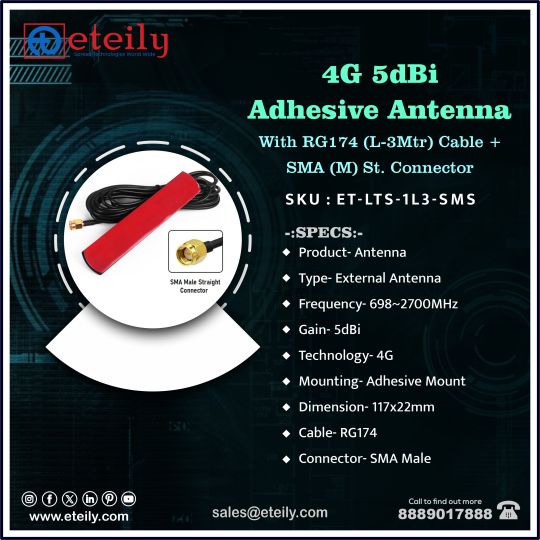
4G 5dBi #AdhesiveAntenna With RG174 (L-3Mtr) Cable + SMA (M) St. Connector
SKU: ET-LTS-1L3-SMS
-SPECS:-
• Product Antenna
• Type-External Antenna
• Frequency-698~2700MHz
• Gain- SdBi
• Technology-4G
• Mounting Adhesive Mount
• Dimension-117x22mm
• Cable-RG174
• Connector- SMA Male
Know More At - https://eteily.com/3-rf-antenna


#eteily#technologies#eteilyindia#rfantenna#5g#4g#external#telecom#telecomunication#india
#5G Outdoor Antenna#4G LTE Antenna#4G Internal Antenna#4G External Antenna#4G Outdoor Antenna#3G Antenna#3G Internal Antenna#3G External Antenna#3G Outdoor Antenna#2G/GSM Antenna#2G Internal Antenna#2G External Antenna#2G Outdoor Antenna#IoT Lora LPWAN#868MHz Antenna#433MHz Antenna#915MHz Antenna#925MHz Antenna#865MHz Antenna#GPS-GNSS ANTENNA
0 notes
Link
4G LTE antenna is a high-performance antenna. The ultra-wide frequency band covers all contemporary LTE operating frequencies gain across all frequencies. Get deals on 4G LTE Antenna Booster in Electronics on Campus Component. For more details Visit https://www.classifiedads.com/electronics/dfbcbwvjj3cf4
0 notes
Link
1 note
·
View note
Text
#rfantenna#cable#charger#eteily#simcardholder#antenna#Eteily is well known Brand in the india for RF Antenna Radio frequency antenna. RF from DC to 18Ghz and RF Families like 868MHz Antenna#LoRa Antenna#433MHz Antenna#LTE Antenna#4G#5G Antenna#WCDMA 3G Antenna#5.8GHz Antenna#Bluetooth Antenna General OSM Antenna.
0 notes
Text
Calling Long-Distance: 10 Stellar Moments in 2022 for Space Communications and Navigation
Just like your phone needs Wi-Fi or data services to text or call – NASA spacecraft need communication services.
Giant antennas on Earth and a fleet of satellites in space enable missions to send data and images back to our home planet and keep us in touch with our astronauts in space. Using this data, scientists and engineers can make discoveries about Earth, the solar system, and beyond. The antennas and satellites make up our space communications networks: the Near Space Network and Deep Space Network.
Check out the top ten moments from our space comm community:
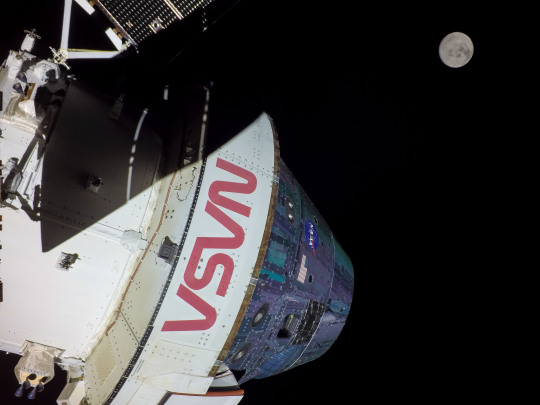
1. Space communication networks helped the Artemis I mission on its historic journey to the Moon. From the launch pad to the Moon and back, the Near Space Network and Deep Space Network worked hand-in-hand to seamlessly support Artemis I. These networks let mission controllers send commands up to the spacecraft and receive important spacecraft health data, as well as incredible images of the Moon and Earth.
The Pathfinder Technology Demonstration 3 spacecraft with hosted TeraByte InfraRed Delivery (TBIRD) payload communicating with laser links down to Earth. Credit: NASA/Ames Research Center
2. Spacecraft can range in size – from the size of a bus to the size of a cereal box. In May 2022, we launched a record-breaking communication system the size of a tissue box. TBIRD showcases the benefits of a laser communications system, which uses infrared light waves rather than radio waves to communicate more data at once. Just like we have upgraded from 3G to 4G to 5G on our phones, we are upgrading its space communications capabilities by implementing laser comms!

3. The Deep Space Network added a new 34-meter (111-foot) antenna to continue supporting science and exploration missions investigating our solar system and beyond. Deep Space Station 53 went online in February 2022 at our Madrid Deep Space Communications Complex. It is the fourth of six antennas being added to expand the network’s capacity.

4. You’ve probably seen in the news that there are a lot of companies working on space capabilities. The Near Space Network is embracing the aerospace community’s innovative work and seeking out multiple partnerships. In 2022, we met with over 300 companies in hopes of beginning new collaborative efforts and increasing savings.

5. Similar to TBIRD, we're developing laser comms for the International Space Station. The terminal will show the benefits of laser comms while using a new networking technique called High Delay/Disruption Tolerant Networking that routes data four times faster than current systems. This year, engineers tested and proved the capability in a lab.

6. In 2021, we launched the James Webb Space Telescope, a state-of-the-art observatory to take pictures of our universe. This year, the Deep Space Network received the revolutionary first images of our solar system from Webb. The telescope communicates with the network’s massive antennas at three global complexes in Canberra, Australia; Madrid, Spain; and Goldstone, California.

7. Just like we use data services on our phone to communicate, we'll do the same with future rovers and astronauts exploring the Moon. In 2022, the Lunar LTE Studies project, or LunarLiTES, team conducted two weeks of testing in the harsh depths of the Arizona desert, where groundbreaking 4G LTE communications data was captured in an environment similar to the lunar South Pole. We're using this information to determine the best way to use 4G and 5G networking on the Moon.
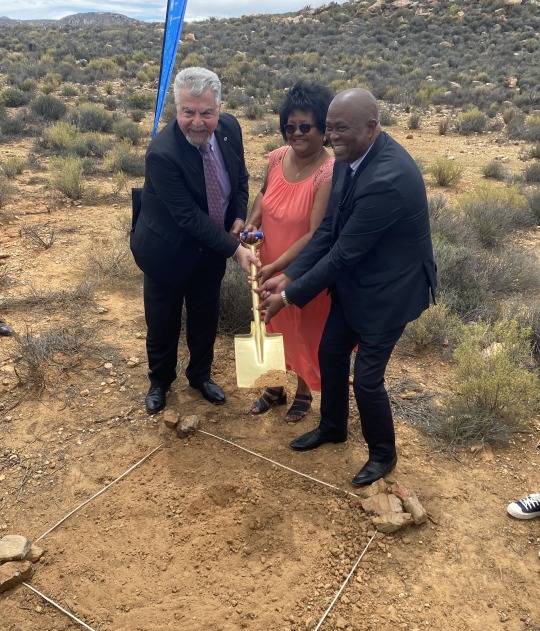
8. A new Near Space Network antenna site was unveiled in Matjiesfontein, South Africa. NASA and the South African Space Agency celebrated a ground-breaking at the site of a new comms antenna that will support future Artemis Moon missions. Three ground stations located strategically across the globe will provide direct-to-Earth communication and navigation capabilities for lunar missions.

9. Quantum science aims to better understand the world around us through the study of extremely small particles. April 14, 2022, marked the first official World Quantum Day celebration, and we participated alongside other federal agencies and the National Quantum Coordination Office. From atomic clocks to optimizing laser communications, quantum science promises to greatly improve our advances in science, exploration, and technology.

10. We intentionally crashed a spacecraft into an asteroid to test technology that could one day be used to defend Earth from asteroids. The Double Asteroid Redirection Test, or DART, mission successfully collided with the asteroid Dimorphos at a rate of 4 miles per second (6.1 kilometers per second), with real-time video enabled by the Deep Space Network. Alongside communications and navigation support, the global network also supports planetary defense by tracking near-Earth objects.
We look forward to many more special moments connecting Earth to space in the coming year.
Make sure to follow us on Tumblr for your regular dose of space!
1K notes
·
View notes
Text
Advantages and disadvantages of 5G
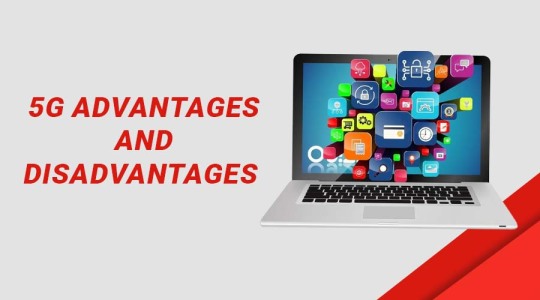
5G technology or fifth generation technology offers many features for mobile networks. It is useful for government, students, businesses and professionals. It is a new mobile network designed to connect everyone and everything. It is the new standard in global wireless networks after 1G to 4G. It offers high multi-Gbps data speeds, low latency, large network capacity, and a flexible user experience. As this new technology is deployed, 5G technology should create many new applications.
5G technology features in brief. Speed up to 10 Gbits.
Great app
100 times more device connections
Fast response time
Waste of time
Another software option to upgrade. Great potential
With the proliferation of digital around the world, when live streaming and games, sports, news, movie reviews, social media, etc., the transfer of large amounts of data from one host to another and the Internet of Things (IoT) spurred the development of mobile phone standards. .
However, the 5G technology network has not yet reached its potential because the existing devices and infrastructure are not yet ready to support the 5G technology network. Those who have tested the 5G technology network using it with built-in 4G devices in this application are also called non-stationary 5G technology networks. The full potential of 5G technology will only be realized when independent networks, compatible devices and better communication tower technologies become available.
Advantages of 5G technology
Transfer data faster
The previous generation 4G LTE technology used bands below 3 GHz but in comparison, 5G technology uses bandwidth from 6 GHz in length to 24 GHz. However, it is important to note that 5G technology coverage also requires a base station and a broadcast tower compared to a 4G data network.
Improved network
5G networks are more flexible as they work with different customers, services and market segments. It divides its network in such a way that it will adapt to the needs of the users. It is based on Network Functions Virtualization (NFV) and Software Defined Networking (SDN). It is also called a "network fragment". This provides high data rates, low power consumption, and reliable low latency.
Moving Beamforming
Moving Beamforming refers to a radio signal processing technique that allows for the transmission or reception of a directional network, unlike a passive antenna that beams the signal randomly in all directions. 4G networks also use beamforming to some capacity, but in a growing sense.
Benefits for companies and businesses
It provides improved machine-to-machine communication for automation, real-time communication and guaranteed network availability, digitization of healthcare and agricultural industries.
Benefits for consumers
It provides fast download and download times when you are streaming users. Stable connection to mobile communications, low response time for online or cloud gaming, virtual reality, high quality live TV and 4K video telephony.
A more secure network
5G technology networks offer more security than previous generation networks. It supports protection against data loss, data corruption and theft. The exchange of sensitive and private customer data, such as hospital patient reports, customer data and student information at universities, is more secure in the 5G technology network.
Disadvantages of 5G
Limit coverage
The 5G technology network is a new technology, it requires a large network of ports and transmission towers worldwide, which requires a lot of time, testing, testing and setting up 5G technology towers.
Reduces durability
If the experts are to be believed, the non-standard 5G technology network undermines the performance of 4G network devices. Although a few manufacturers have started to produce 5G technology network devices, R & D believes that due to high data transmission in the largest network, the longevity or service life of mobile phones and other devices will be compromised.
Involvement in aviation
In January, Air India cancled several flights to the United States because they were rolling out 5G technology services in the country. This is a major setback of 5G technology in India as airlines have suffered losses due to ongoing 5G technology deployment projects. It can also be a hindrance in the future if not dealt with quickly. Internet Security Threats
Although the 5G technology network is said to help improve cybersecurity, it also has its limitations as it encourages cloud computing and exposes more data to risk. of hacking due to its lack of privacy and ease of access to network networks. on the other hand. hands
5G technologyin India
India officially launched its 5G technology network in October this year at an event held in New Delhi. Airtel and Jio have started rolling out 5G technology data plans in select state. However, Vodafone Idea is not planning to launch it in the near future.
In case of Airtel, they are currently placed in Tier I to Tier 8 countries. Jio has launched 5G technology services in limited areas. Many telecom operators are also of the opinion that pan-India 5G technology network coverage will take a few years. Jio recently announced after the 5G technology beta test that no SIM card is required to operate Jio's 5G technology network. However, Vodafone Idea has not yet announced its 5G technology network.
The health risks of 5G technology and the disadvantages of 5G technology for the environment
The International Commission on Non-ionizing Radiation Protection (ICNIRP) has stated that increasing radio frequencies above 6 GHz may have biological and health effects. The 5G technology network will increase the amount of electromagnetic radiation in the environment, causing a greater risk of cancer. With the lack of power of 5G technology network devices, there will also be an increase in the collection of electronic waste. The electric current from the cell tower exposed sparrows and other birds to increased egg production and nesting behavior. High rates of energy consumption have also contributed to global warming.
7 notes
·
View notes
Text
The Multiple Input Multiple Output (MIMO) Market is poised for substantial growth, with the market size expected to reach USD 10,895 million in 2024 and projected to expand to USD 23,524.79 million by 2032, reflecting a robust CAGR of 10.1% during the forecast period. Multiple Input Multiple Output (MIMO) is a wireless technology that enhances data transmission efficiency and speed by utilizing multiple antennas at both the transmitter and receiver ends. This technique, which allows the simultaneous transmission and reception of multiple data signals over the same radio channel, significantly improves network capacity and reliability. MIMO technology has become a cornerstone in modern wireless communication systems, especially in applications such as 4G LTE, Wi-Fi, and 5G networks.
Browse the full report at https://www.credenceresearch.com/report/multiple-input-multiple-output-mimo-market
Market Dynamics
The MIMO market has experienced substantial growth over the past few years, primarily driven by the increasing demand for faster and more reliable wireless communication systems. The rapid adoption of smartphones, tablets, and other connected devices has led to a surge in data traffic, necessitating improved wireless infrastructure. As a result, MIMO technology has become essential for mobile operators and equipment manufacturers to enhance data throughput and provide seamless connectivity.
The rollout of 5G networks has also played a pivotal role in the expansion of the MIMO market. 5G networks rely heavily on MIMO technology, particularly massive MIMO, which employs hundreds or even thousands of antennas to deliver high-speed, low-latency communication. The ability of MIMO to improve spectrum efficiency and support more users in dense urban areas has made it a key enabler of 5G technology.
Key Market Drivers
1. Rising Demand for High-Speed Wireless Connectivity: With the growing reliance on digital services, there is a surging demand for faster and more reliable internet connections. MIMO technology helps meet this demand by enabling higher data transfer rates, making it a crucial component in wireless networks.
2. Proliferation of Smart Devices and IoT: The increasing number of connected devices, including smartphones, smart home devices, and IoT sensors, has led to a significant rise in data traffic. MIMO technology supports higher capacity and better performance in congested networks, ensuring smooth communication for all devices.
3. Adoption of 5G Networks: The deployment of 5G networks is one of the most significant drivers of the MIMO market. 5G relies heavily on MIMO, especially massive MIMO, to provide enhanced coverage, increased capacity, and ultra-low latency. As more countries and telecom operators roll out 5G infrastructure, the demand for MIMO-enabled equipment continues to grow.
4. Advancements in Wi-Fi Technology: MIMO is also a critical component in modern Wi-Fi standards, such as Wi-Fi 6 (802.11ax) and the upcoming Wi-Fi 7. These standards utilize MIMO to improve data transfer speeds, reduce latency, and increase the number of devices that can be connected simultaneously. The growing adoption of these Wi-Fi technologies is expected to boost the demand for MIMO solutions.
Challenges and Restraints
Despite its advantages, the MIMO market faces several challenges. One of the primary concerns is the complexity of MIMO systems. Implementing multiple antennas and managing interference between signals can be technically challenging, leading to increased costs for network operators. Additionally, the integration of MIMO technology into existing networks can require significant investment in hardware and software upgrades.
Another challenge is the regulatory environment. In some regions, spectrum allocation and licensing issues can hinder the deployment of MIMO technology, particularly in the context of 5G networks.
Future Outlook
The future of the MIMO market looks promising, driven by the continued expansion of 5G networks, the evolution of Wi-Fi standards, and the growing demand for high-speed wireless connectivity. Massive MIMO, in particular, is expected to play a crucial role in shaping the next generation of wireless communication systems, enabling faster, more reliable, and more efficient networks.
Moreover, as industries such as automotive, healthcare, and smart cities increasingly rely on connected devices and IoT solutions, the demand for MIMO technology will only grow. The integration of MIMO into emerging technologies such as autonomous vehicles and smart infrastructure will create new opportunities for market expansion.
Key Player Analysis:
Qualcomm Technologies, Inc.
Ericsson
Huawei Technologies Co., Ltd.
Nokia Corporation
ZTE Corporation
Samsung Electronics Co., Ltd.
Intel Corporation
Cisco Systems, Inc.
Broadcom Inc.
NEC Corporation
Segmentations:
By Technology:
LTE
5G
By Type:
Single Input Multiple Output (SIMO)
Multiple Input Single Output (MISO)
Multiple Input Multiple Output (MIMO)
By Application:
Wi-Fi Hotspots
Smart Home Devices
Mobile Broadband Connections
Fixed Wireless Access
Smartphones
Others (laptops, tablets)
By Antenna Type:
Single User MIMO
Multi-User MIMO
Massive MIMO
Others (Sierra Wireless MG90)
By End User:
Telecom Operators
Automotive
Government
Healthcare
Others (Industrial, Enterprise, etc.)
By Region
North America
The U.S
Canada
Mexico
Europe
Germany
France
The U.K.
Italy
Spain
Rest of Europe
Asia Pacific
China
Japan
India
South Korea
South-east Asia
Rest of Asia Pacific
Latin America
Brazil
Argentina
Rest of Latin America
Middle East & Africa
GCC Countries
South Africa
Rest of Middle East and Africa
Browse the full report at https://www.credenceresearch.com/report/multiple-input-multiple-output-mimo-market
About Us:
Credence Research is committed to employee well-being and productivity. Following the COVID-19 pandemic, we have implemented a permanent work-from-home policy for all employees.
Contact:
Credence Research
Please contact us at +91 6232 49 3207
Email: [email protected]
Website: www.credenceresearch.com
0 notes
Text
Automotive V2X Antenna Market: Key Trends, Technological Advancements, and Growth Outlook for 2024

Introduction to the Automotive V2X Antenna Market
The automotive V2X (Vehicle-to-Everything) antenna market is at the forefront of the rapidly evolving automotive industry, driven by the increasing demand for connected and autonomous vehicles. V2X communication enables vehicles to communicate with other vehicles (V2V), infrastructure (V2I), pedestrians (V2P), and networks (V2N), enhancing road safety, reducing traffic congestion, and improving driving efficiency. V2X antennas play a crucial role in enabling this communication by transmitting and receiving signals, ensuring seamless data exchange between vehicles and their surroundings. As the automotive industry shifts towards smart mobility, the automotive V2X antenna market is set for substantial growth.
This article explores the trends, growth drivers, challenges, and future outlook for the automotive V2X antenna market, providing insights into the technological advancements and key factors shaping the future of connected vehicles.
Read the Full Report Here:
https://www.reportprime.com/automotive-v2x-antenna-r11731
Market Overview and Growth Projections
The global automotive V2X antenna market is expected to grow at a compound annual growth rate (CAGR) of approximately 17% from 2024 to 2030. The rapid advancement of autonomous driving technologies, increasing government initiatives for intelligent transportation systems (ITS), and the growing adoption of electric and connected vehicles are key factors driving the growth of the V2X antenna market.
Key factors contributing to the market's expansion include:
Rise of Autonomous and Connected Vehicles: The increasing development and deployment of autonomous and semi-autonomous vehicles are driving the demand for V2X communication systems, in which antennas play a critical role.
Government Mandates for V2X Technology: Governments worldwide are implementing regulations and incentives to accelerate the adoption of V2X technology, promoting road safety and efficient traffic management.
Growing Investments in Smart City Projects: The integration of V2X antennas into smart city infrastructure for connected mobility and traffic management is boosting market demand.
Key Market Segments
By Antenna Type:
Embedded V2X Antennas: Embedded antennas are integrated within the vehicle’s structure, ensuring discreet and streamlined communication. They are popular in modern, sleek vehicle designs where aesthetics are important.
External V2X Antennas: External antennas are mounted outside the vehicle, providing a wider range of communication capabilities and signal strength. These antennas are often found in larger vehicles like trucks and commercial fleets.
By Frequency Band:
Dedicated Short-Range Communication (DSRC): DSRC-based V2X systems operate in the 5.9 GHz frequency band and are widely used for vehicle-to-vehicle (V2V) and vehicle-to-infrastructure (V2I) communication. DSRC has been a standard in the development of connected vehicles.
Cellular V2X (C-V2X): C-V2X operates on cellular networks, including 4G LTE and 5G, providing higher data transmission rates and broader communication capabilities. C-V2X is gaining traction due to its scalability and ability to support real-time communication.
By Application:
Passenger Vehicles: Passenger cars are the largest segment of the automotive V2X antenna market, driven by the growing adoption of connected vehicle technologies and increasing demand for enhanced safety features.
Commercial Vehicles: V2X technology in commercial vehicles is essential for fleet management, logistics, and improving safety on highways. The demand for V2X antennas is growing in this segment as commercial fleet operators adopt smart transportation solutions.
Electric Vehicles (EVs): As EVs become more popular, the integration of V2X technology for enhanced charging, communication, and energy management is gaining momentum, driving demand for specialized V2X antennas.
Key Drivers of Market Growth
1. Increasing Adoption of Autonomous Vehicles
The shift towards autonomous driving is one of the primary drivers of the automotive V2X antenna market. Autonomous vehicles rely on continuous communication with their surroundings to navigate safely and efficiently. V2X antennas are essential for enabling this communication, ensuring that vehicles can interact with traffic signals, pedestrians, and other vehicles in real-time.
2. Government Initiatives for Road Safety and Traffic Management
Governments worldwide are mandating the implementation of V2X technology in vehicles to improve road safety and reduce traffic congestion. For example, the European Union, the U.S., and China are actively promoting the use of V2X communication in smart city projects and transportation infrastructure. These initiatives are driving the demand for V2X antennas in the automotive industry.
3. Development of 5G Technology
The rollout of 5G technology is expected to accelerate the adoption of C-V2X antennas in vehicles. 5G’s low latency and high data transmission capabilities enable real-time communication between vehicles and their environment, enhancing the safety and efficiency of autonomous driving systems. The increasing use of 5G networks in connected vehicle ecosystems will significantly boost the V2X antenna market.
4. Rise of Electric Vehicles (EVs) and Smart Charging
Electric vehicles are increasingly incorporating V2X technology to enable smart charging, energy management, and vehicle-to-grid (V2G) communication. V2X antennas allow EVs to interact with charging stations and optimize energy usage, reducing charging times and improving overall grid efficiency.
Challenges in the Automotive V2X Antenna Market
1. High Implementation Costs
One of the key challenges in the automotive V2X antenna market is the high cost of implementing V2X technology. The integration of V2X communication systems requires significant investment in infrastructure, including antennas, sensors, and communication networks. This can be a barrier to adoption, particularly in developing regions where budget constraints may limit the deployment of V2X technology.
2. Security and Privacy Concerns
As vehicles become more connected, security and privacy concerns become more prominent. V2X communication systems are vulnerable to cyberattacks, which could compromise vehicle safety and data integrity. Ensuring robust cybersecurity measures for V2X antennas and communication networks is critical to overcoming this challenge.
3. Interoperability Issues
The adoption of different communication protocols, such as DSRC and C-V2X, can create interoperability challenges between vehicles and infrastructure. Ensuring that V2X antennas can support multiple communication protocols and operate seamlessly across different systems is essential for widespread V2X deployment.
Key Players in the Automotive V2X Antenna Market
Several major companies are driving innovation and growth in the automotive V2X antenna market, offering advanced solutions to meet the evolving needs of the automotive industry:
Continental AG: A leading player in automotive technology, Continental provides a range of V2X antennas and communication systems that enable vehicle connectivity and enhance road safety.
Denso Corporation: Denso is a key manufacturer of automotive V2X components, including antennas, offering solutions for both DSRC and C-V2X communication systems.
Ficosa International S.A.: Ficosa specializes in providing advanced V2X antennas and telecommunication systems for connected vehicles, focusing on innovation in antenna design and performance.
Laird Connectivity: Laird is known for its cutting-edge antenna technology, offering V2X antennas that support both DSRC and C-V2X communication, providing high-performance solutions for connected vehicles.
TE Connectivity: TE Connectivity offers a wide range of automotive V2X antennas, providing innovative communication solutions for autonomous and connected vehicles.
Future Outlook and Opportunities
The automotive V2X antenna market is poised for rapid growth as the automotive industry shifts towards connected and autonomous mobility. The integration of 5G technology, increasing demand for electric vehicles, and government initiatives for smart transportation systems will create significant opportunities for manufacturers in the coming years.
Regional Outlook:
North America: North America is expected to lead the V2X antenna market, driven by strong government support for V2X technology adoption and the presence of major automotive manufacturers in the region.
Europe: Europe will see significant growth in the automotive V2X antenna market, fueled by smart city projects and government regulations aimed at improving road safety and reducing traffic congestion.
Asia-Pacific: The Asia-Pacific region, particularly China, will experience rapid growth due to the increasing adoption of connected and autonomous vehicles, as well as government investments in intelligent transportation infrastructure.
Conclusion
The automotive V2X antenna market is set for substantial growth in the coming years, driven by the rise of autonomous vehicles, advancements in 5G technology, and increasing government initiatives for smart transportation systems. While challenges such as high implementation costs and security concerns exist, the future of the market remains promising. Manufacturers that focus on innovation, cybersecurity, and interoperability will be well-positioned to capitalize on the opportunities in this rapidly evolving industry.
Explore similar Reports for valuable insights:
https://www.reportprime.com/subsea-vessels-r11726
https://www.reportprime.com/riot-control-vehicle-r11727
https://www.reportprime.com/brake-blocks-r11728
https://www.reportprime.com/engineering-vehicles-r11729
https://www.reportprime.com/automobile-differential-r11730
https://www.reportprime.com/automotive-snow-chains-r11732
https://www.reportprime.com/slipper-clutch-r11733
https://www.reportprime.com/smart-bumper-r11734
https://www.reportprime.com/automotive-bumper-r11736
https://www.reportprime.com/automotive-electric-power-steering-r11737
0 notes
Text

Cell Phone Booster, Cover 7,000 Sq Ft Cell Phone Signal Booster with LCD Touch Screen High Gain for Home Office Support All U.S Carriers, FCC Approved
Click on this link to order yours today:
https://amzn.to/4cvtzl6
BrandHiBoostWireless Communication Standard802.11axSpecial FeatureHiboost App, LCD Touch ScreenConnector TypeUSB Type AColorMate Pro
About this item
🏡【Cell Signal Booster for Home】Hiboost cell phone signal amplifier boosts weak signal 100x, It offers an extension that covers 7000 square feet. which can enhance the signal for homes with 3-4 rooms, offices, basements, metal buildings, etc.
📶【Indoor Two Antenna and LCD Touch】Cell phone booster through AGC to intelligently detect signal strength, built-in antenna, and separate indoor antenna to ensure you get the best performance with stable output, and you can view and adjust the gain effect through the LCD touch screen so that your calls can enjoy fewer dropped calls, extremely fast data speeds, and better voice quality.
💡【5G Compatible and Supports All Carriers】Hiboost cell phone booster supports all US and Canadian carriers including AT&T, Verizon, T-Mobile, Straight Talk, U.S. Cellular, etc. It is compatible with 2G, 3G, 4G LTE, and 5G (only supports 5G that is heavily deployed by carriers in existing 4G bands via DSS), and supports bands 2/4/5/12/13/17/25.
⚙️【Fast Installation and App】SignalSupervisor App helps fine-tune the best output and see how strong the signal is. No drills are necessary since the window wire can be fed through the window bottom to connect the outdoor antenna and the cell signal booster. Even if you have no installation experience, you can easily complete the DIY installation process by following the step-by-step guide.
0 notes
Text
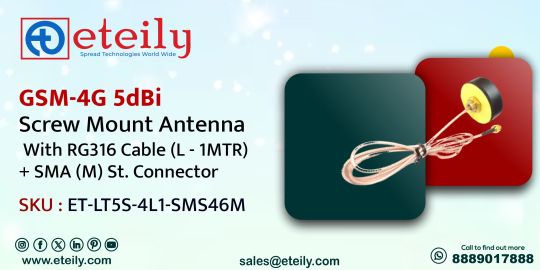
GSM-4G 5dBi Screw Mount Antenna With RG316 Cable (L - 1MTR) + SMA (M) St. Connector
The "#screwmount" indicates that the antenna can be attached to a surface using screws. This type of mount is common for easy installation on various #devices or structures.
SKU : ET-LT5S-4L1-SMS46M
For More Info - https://eteily.com/
#eteily#technologies#eteilyindia#telecom#telecomunication#screwmount#rfantenna#5G#4G#5GTechnology#India
#5g antenna#5G Internal Antenna#5G External Antenna#5G Outdoor Antenna#4G LTE Antenna#4G Internal Antenna#4G External Antenna#4G Outdoor Antenna#3G Antenna#3G Internal Antenna#3G External Antenna#3G Outdoor Antenna#2G/GSM Antenna#2G Internal Antenna#2G External Antenna#2G Outdoor Antenna#IoT Lora LPWAN#868MHz Antenna#433MHz Antenna#915MHz Antenna#925MHz Antenna#865MHz Antenna#GPS-GNSS ANTENNA#External GNSS GPS#Magnetic Antenna#Screw Mount Antenna#Adhesive Mount Antenna#GNSS GPS Marine Antenna
0 notes
Text
Eteily is well known brand in India for RF Antennas Radio frequency Antenna. Radio frequencies from DC to 18GHz and RF Families like IoT Antenna, 868MHz Antenna, LoRa Antenna, 433MHz Antenna,5G Antenna, LTE Antenna, 4G Antenna, WCDMA 3G Antenna, 5.8GHz Antenna, 2.4GHz Antenna, Bluetooth Antenna, RF Antenna Solutions, Cellular Antenna, General ISM Antenna, Navigation Antenna, Wi-Fi Antenna, and 802.15 Antenna.
0 notes
Link
#5G Network#5G Private Network#Private 5G#private 5g networks#private network#4G LTE#GSM#c&t rf antennas inc#Wifi
1 note
·
View note
Text
Centralino Tv per Bande 345U con Guadagno di 40dB Regolabili Filtro Lte/5G
Centralino Tv per Bande 345U con Guadagno di 40dB Regolabili Filtro Lte/5G
432 – EFFE CLM-345U-119
Centralino Tv per Bande 345U con Guadagno di 40dB (Regolabili) per impianti centralizzati tv – Centralino antenna con Filtro Lte/4G Integrato
Bande amplificate: III (05-12) + IV (21-36) + V (37-60) + UHF (21-60)
Filtro Lte/4G integrato
Taglio Lte: CH. 60 (possibilità di taglio per CH. 58 o CH.…
0 notes
Text

Resilient for Demanding Industrial Settings
Engineered to withstand demanding conditions, SR500 4g industrial router routers feature:
- Rugged enclosures to resist vibration, shock and extreme temperatures from -40°C to 75°C
- IP30 rating to prevent dust and moisture ingress
- DIN rail or desktop mounting for secure installation
- Redundant cellular and WiFi prevents downtime from network outages
Powerful Cellular and WiFi Connectivity
The SR500 line supports:
- 4G LTE CAT4 providing up to 150Mbps down/50Mbps up for high-bandwidth applications
- Optional 1.8GHz private LTE with 1000m range for campus and industrial park coverage
- 802.11b/g/n WiFi with internal or external antennas for local wireless access
This enables combining long-range cellular and short-range WiFi in one router.
Advanced Networking Features

SR500 routers provide:
- 2 x 10/100Mbps Ethernet ports for wired connectivity
- Extensive VPN protocols like IPsec, OpenVPN, GRE for secure remote communications
- SD-WAN capabilities to optimize performance across multiple links
- TR-069 and SNMP management for auto-configuration and monitoring
Tailored for Industrial IoT Projects
Typical applications include:
- Connecting PLCs, RTUs, sensors, meters and other assets to cloud platforms
- Enabling public WiFi and smart city services like traffic control and surveillance
- First responder networks with cellular and failover WiFi
- Deploying SD-WAN to combine multiple network links
- Adding cellular connectivity to sites without wired internet access
Customizable Linux Platform
The SR500 runs OpenWrt Linux allowing full customization. Development guides help tailor routers to specific use cases.
Centralized Management for Scalability
Star Device Manager (Star Cloud) enables managing entire networks of routers for simplified provisioning and monitoring. With industrial-grade reliability, the SR500 series provides connectivity assurance for critical industrial IoT.
1 note
·
View note
Text
High-Performance RF Antennas In Telecom
Eteily is well known brand in India for RF Antennas Radio frequency Antenna. Radio frequencies from DC to 18GHz and RF Families like IoT Antenna, 868MHz Antenna, LoRa Antenna, 433MHz Antenna,5G Antenna, LTE Antenna, 4G Antenna, WCDMA 3G Antenna, 5.8GHz Antenna, 2.4GHz Antenna, Bluetooth Antenna, RF Antenna Solutions, Cellular Antenna, General ISM Antenna, Navigation Antenna, Wi-Fi Antenna, and 802.15 Antenna.
0 notes